Aufbau principle - Study guides, Class notes & Summaries
Looking for the best study guides, study notes and summaries about Aufbau principle? On this page you'll find 127 study documents about Aufbau principle.
Page 2 out of 127 results
Sort by

-
Chemistry 103 Exam 3 Questions and Answers(A+ Solution guide)
- Exam (elaborations) • 21 pages • 2024
- Available in package deal
-
- $7.99
- + learn more
Which orbital is the electron in? - Answer-l (L) value which orientation is the electron in? - Answer-m sub L value n value - Answer-use periodic table (period #) L value - Answer-what orbital its in (s, p, d, f) m sub L value - Answer-what orientation of the orbital is it in?---every electron in the atom has unique values for n, l, ml Electron configurations show... - Answer-which orbitals are in an atom and how the electrons fill the orbitals Electron configurations focus on... - Answe...
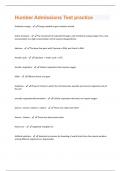
-
Humber Admissions Test practice Questions and Answers with complete solution
- Exam (elaborations) • 15 pages • 2024
- Available in package deal
-
- $7.99
- + learn more
Activation energy - Energy needed to get a reaction started Active transport - The movement of materials through a cell membrane using energy; from a low concentration to a high concentration until it reaches disequilibrium. Adenine - The base that pairs with Thymine in DNA, and Uracil in RNA Aerobic cycle - Glycolysis -> Kreb's cycle -> ETC Aerobic respiration - Cellular respiration that requires oxygen Allele - Different forms of a gene Anaphase - Phase of mitosis in which the ch...
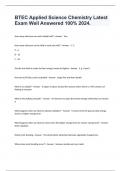
-
BTEC Applied Science Chemistry Latest Exam Well Answered 100% 2024.
- Exam (elaborations) • 15 pages • 2024
- Available in package deal
-
- $9.99
- + learn more
How many electrons can each orbital hold? - Answer Two How many electrons can be held in each sub shell? - Answer S - 2 P - 6 D - 10 F - 18 Put the sub shells in order do their energy, lowest to highest - Answer S, p, d and f How do we fill the p and d subshells - Answer singly first and then doubly What is an orbital? - Answer A region of space around the nucleus where there is a 95% chances of finding an electron What is the Aufbau principle? - Answer An electron...
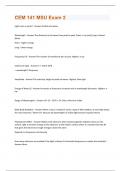
-
CEM 141 MSU Exam 2 Questions with 100% Correct Answers | Verified
- Exam (elaborations) • 12 pages • 2024
- Available in package deal
-
- $7.99
- + learn more
Lights acts as what? - Answer-Particle and wave. Wavelength - Answer-The distance (m) of waves from peak to peak. Short: x-ray (red), long: infrared (blue) Short - higher energy Long - lower energy Frequency (V) - Answer-The number of wavefronts per second. Highest: x-ray Velocity of Light - Answer-C = 3.00 X 10^8 = wavelength X frequency Amplitude - Answer-The intensity, height of peaks of waves. Highest: blue light Energy of Wave (J) - Answer-Increases as frequency increases and as wa...
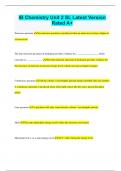
-
IB Chemistry Unit 2 SL Latest Version Rated A+
- Exam (elaborations) • 9 pages • 2024
- Available in package deal
-
- $9.99
- + learn more
IB Chemistry Unit 2 SL Latest Version Rated A+ Emission spectrum An emission spectrum is produced when an atom moves from a higher to a lower level. The line emission spectrum of hydrogen provides evidence for __________________ which converge at _____________ The line emission spectrum of hydrogen provides evidence for the existence of electrons in discrete energy levels which converge at higher energies. Continuous spectrum All the colours / wavelengths present merge smoothly in...
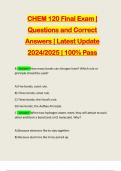
-
CHEM 120 Final Exam | Questions and Correct Answers | Latest Update 2024/2025 | 100% Pass
- Exam (elaborations) • 58 pages • 2024
- Available in package deal
-
- $11.99
- + learn more
CHEM 120 Final Exam | Questions and Correct Answers | Latest Update 2024/2025 | 100% Pass B - Answer -How many bonds can nitrogen have? Which rule or principle should be used? A) Five bonds; octet rule. B) Three bonds; octet rule. C) Three bonds; the Hund's rule. D) Five bonds; the Aufbau Principle. C - Answer -When two hydrogen atoms meet, they will attract to each other and form a bond (and a H2 molecule). Why? A) Because electrons like to stay together. B) Because electrons li...
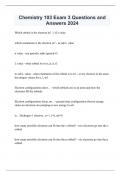
-
Chemistry 103 Exam 3 Questions and Answers 2024
- Exam (elaborations) • 24 pages • 2024
- Available in package deal
-
- $12.99
- + learn more
Which orbital is the electron in? - l (L) value which orientation is the electron in? - m sub L value n value - use periodic table (period #) L value - what orbital its in (s, p, d, f) m sub L value - what orientation of the orbital is it in?---every electron in the atom has unique values for n, l, ml Electron configurations show... - which orbitals are in an atom and how the electrons fill the orbitals Electron configurations focus on... - ground state configuration (lowest en...
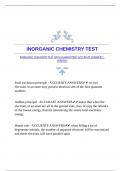
-
INORGANIC CHEMISTRY TEST WITH GUARANTEED ACCURATE ANSWERS |VERIFIED
- Exam (elaborations) • 7 pages • 2024
- Available in package deal
-
- $11.49
- + learn more
Pauli exclusion principle - ACCURATE ANSWERS no two electrons in an atom may possess identical sets of the four quantum numbers Aufbau principal - ACCURATE ANSWERS states that when the electrons of an atom are all in the ground state, they occupy the orbital's of the lowest energy, thereby minimizing the atoms total electronic energy. Hunds rule - ACCURATE ANSWERS when filling a set of degenerate orbitals, the number of unpaired electrons will be maximized and these electrons will have pa...

-
Straighterline Chemistry Topic 4| Questions Answered 100% Correct/Verified Solutions
- Exam (elaborations) • 3 pages • 2024
- Available in package deal
-
- $9.49
- + learn more
Valence electron Electrons on the outermost energy level of an atom. The electrons in the highest energy level. Aufbau Principle the rule that electrons occupy the orbitals of lowest energy first. The principle used to add electrons to successive orbitals on an atom. “The orbitals with lower energies are filled before those with higher energies”.
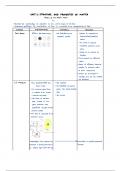
-
Grade 12 Chemistry: Structures and Properties of Matter
- Interview • 39 pages • 2023
- Available in package deal
-
- $7.99
- 1x sold
- + learn more
Grade 12 Chemistry Notes on the Structure and Properties of Matter. Includes topics varying from the current model of the atom, light, the photoelectric electric effect, the atomic line spectra, wave particle duality, heisenberg's uncertainty principle, quantum numbers, electron configuration, hund's rule, pauli exclusion principle, aufbau principle, orbital diagrams, electron configuration, valence bond theory and orbital hybridization, VSEPR, covalent bonding and polarity, periodic table tre...

Do you wonder why so many students wear nice clothes, have money to spare and enjoy tons of free time? Well, they sell on Stuvia! Imagine your study notes being downloaded a dozen times for $15 each. Every. Single. Day. Discover all about earning on Stuvia


